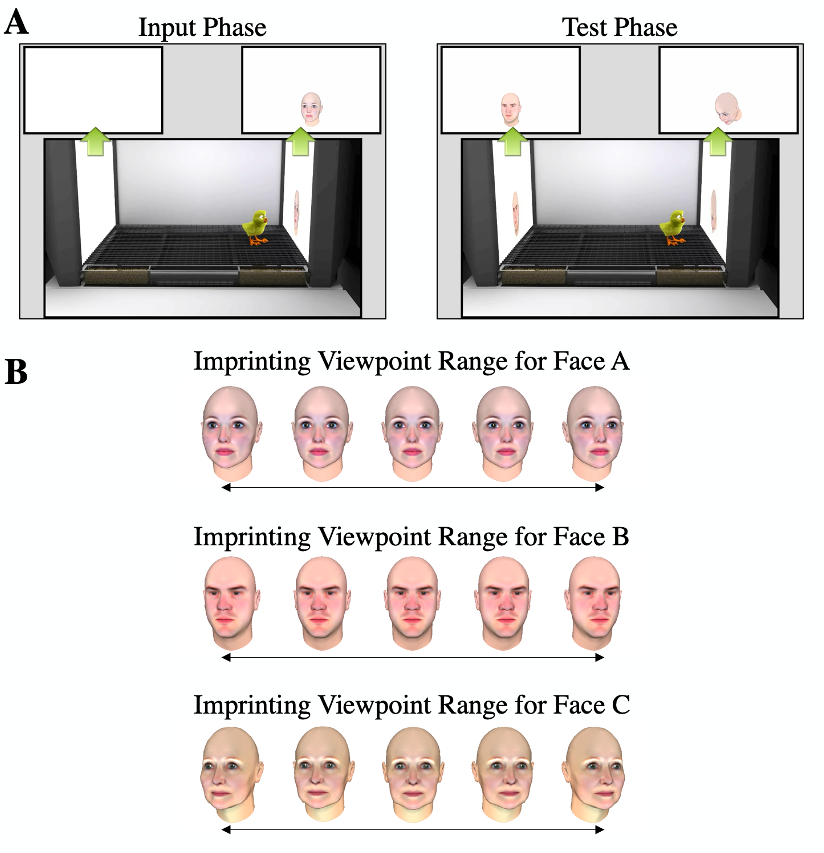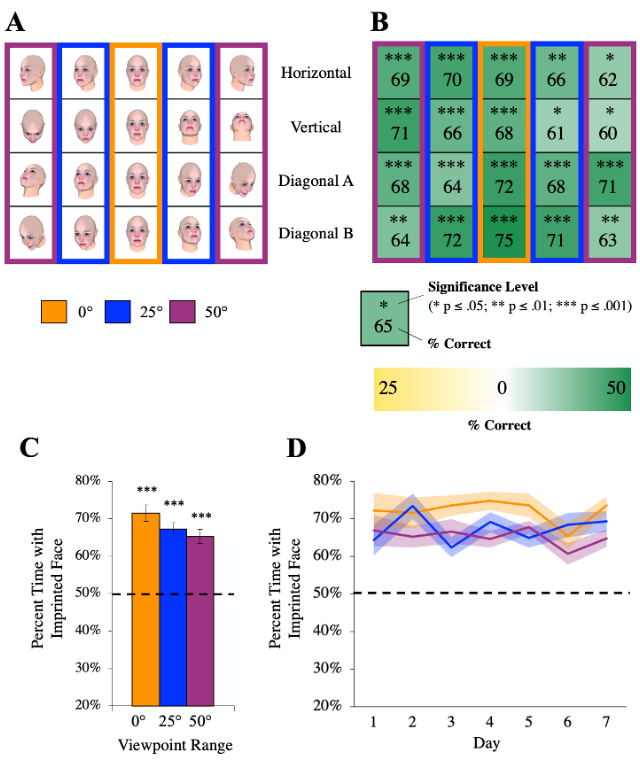Samantha M. W. Wood and Justin N. Wood
What role does experience play in the development of face recognition? A growing body of evidence indicates that newborn brains need slowly changing visual experiences to develop accurate visual recognition abilities. All of the work supporting this ‘slowness constraint’ on visual development comes from studies testing basic-level object recognition. Here, we present the results of controlled-rearing experiments that provide evidence for a slowness constraint on the development of face recognition, a prototypical subordinate-level object recognition task. We found that (1) newborn chicks can rapidly develop view-invariant face recognition and (2) the development of this ability relies on experience with slowly moving faces. When chicks were reared with quickly moving faces, they built distorted face representations that largely lacked invariance to viewpoint changes, effectively ‘breaking’ their face recognition abilities. These results provide causal evidence that slowly changing visual experiences play a critical role in the development of face recognition, akin to basic-level object recognition. Thus, face recognition is not a hardwired property of vision but is learned rapidly as the visual system adapts to the temporal structure of the animal’s visual environment.
Experiment 1 Methods. (A) During the Input Phase, we reared newborn chicks with a single virtual face rotating through a 20° viewpoint range. During the Test Phase, we presented the chicks with two-alternative forced-choice test trials. One display wall showed the imprinted face from an unfamiliar viewpoint, while the other display wall showed an unfamiliar face from the familiar (imprinted) viewpoint. (B) Each chick was imprinted to either Face A or Face B. The non-imprinted face was used as an unfamiliar face during test trials. Face C also served as an unfamiliar face during test trials for both groups of chicks.
Stimuli and results for Experiment 1. (A) The viewpoints presented during the test phase. The table shows the middle frame of each viewpoint range. (B) The chicks’ face recognition performance for each viewpoint range. Performance (percent correct) is both color-coded and reported as a numeric value, together with its significance according to a two-tailed t-test (see key for significance values). Performance was above chance level (50%) for each viewpoint. (C) The bar graphs show recognition performance as a function of the three degrees of viewpoint change. The chicks’ recognition performance was above chance level for all three of the viewpoint ranges (0°, 25°, and 50°). (D) Overall performance by test day for each viewpoint range. Performance did not improve over the course of the test phase. The shaded ribbon around each line shows ±1 SE.
Illustration of an imprinting animation and the associated test trials. Each chick was imprinted to a single virtual face, then presented with two types of test trials: Viewpoint Trials and Identity Trials. In the Viewpoint Trials (blue box), one display wall showed the imprinted face from the familiar viewpoint range and the other display wall showed the imprinted face from an unfamiliar viewpoint range. In the Identity Trials (red box), one display wall showed the imprinted face from an unfamiliar viewpoint range and the other display wall showed an unfamiliar face from the familiar viewpoint range. A view-invariant face representation should be selective for identity features but not view-specific features.
(A) Results from Experiment 2. Newborn chicks were imprinted to a face that rotated at a slow, medium, or fast speed. Recognition performance varied as a function of the speed of the imprinted face. When the imprinted face moved slowly, the chicks built view-invariant face representations that were selective for identity features but not view-specific features. Conversely, as the imprinted face moved more quickly, the chicks built face representations that were less selective for identity features and more selective for view-specific features. (B) Results from Experiment 3. All of the chicks were imprinted to a slowly moving face, then tested with faces that moved at slow, medium, and fast speeds. Recognition performance did not vary as a function of the speed of the test faces, indicating that chicks can recognize quickly moving faces provided that the face moved slowly when being encoded into memory.
Face recognition performance across the test phase in the Slow, Medium, and Fast Conditions (Experiment 2). Red lines show average performance on the Identity Trials. Blue lines show average performance on the Viewpoint Trials. The ribbons show ±1 SE. Performance did not significantly increase across the test phase in any condition or trial type.




